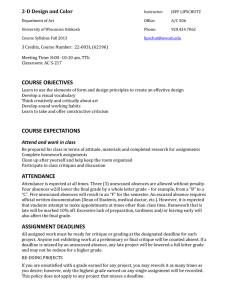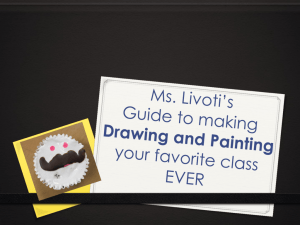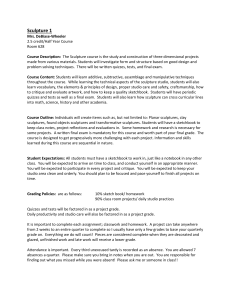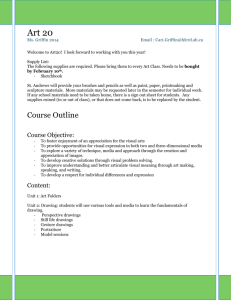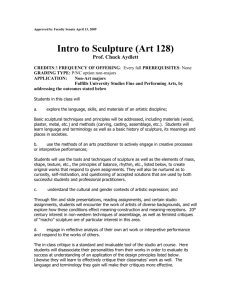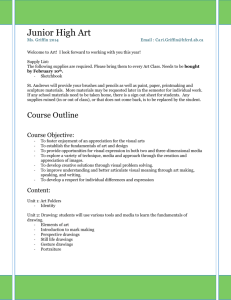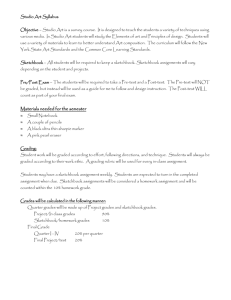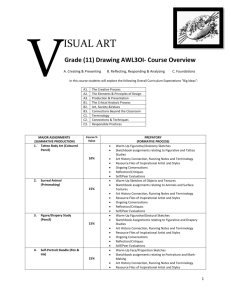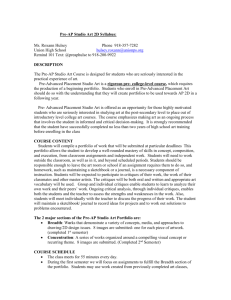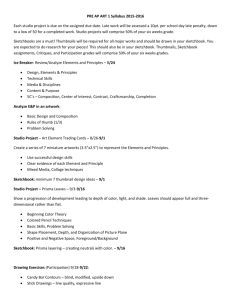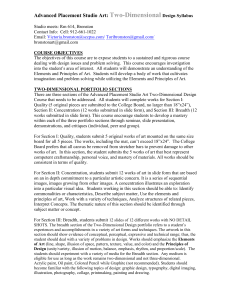Course Syllabus - Bensalem Township School District
advertisement
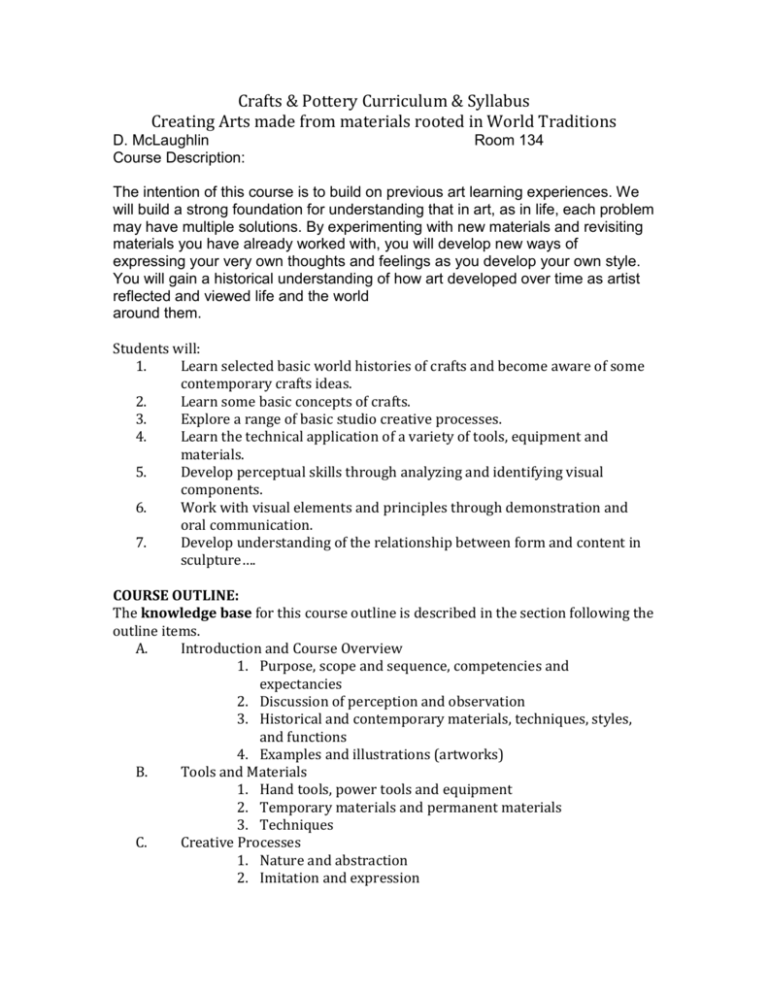
Crafts & Pottery Curriculum & Syllabus Creating Arts made from materials rooted in World Traditions D. McLaughlin Course Description: Room 134 The intention of this course is to build on previous art learning experiences. We will build a strong foundation for understanding that in art, as in life, each problem may have multiple solutions. By experimenting with new materials and revisiting materials you have already worked with, you will develop new ways of expressing your very own thoughts and feelings as you develop your own style. You will gain a historical understanding of how art developed over time as artist reflected and viewed life and the world around them. Students will: 1. Learn selected basic world histories of crafts and become aware of some contemporary crafts ideas. 2. Learn some basic concepts of crafts. 3. Explore a range of basic studio creative processes. 4. Learn the technical application of a variety of tools, equipment and materials. 5. Develop perceptual skills through analyzing and identifying visual components. 6. Work with visual elements and principles through demonstration and oral communication. 7. Develop understanding of the relationship between form and content in sculpture…. COURSE OUTLINE: The knowledge base for this course outline is described in the section following the outline items. A. Introduction and Course Overview 1. Purpose, scope and sequence, competencies and expectancies 2. Discussion of perception and observation 3. Historical and contemporary materials, techniques, styles, and functions 4. Examples and illustrations (artworks) B. Tools and Materials 1. Hand tools, power tools and equipment 2. Temporary materials and permanent materials 3. Techniques C. Creative Processes 1. Nature and abstraction 2. Imitation and expression D. E. F. 3. Function 4. Problem-solving 5. Pre-conceived outcomes 6. Influence of process and material 7. Artist as craftsman and artisan Elements 1. Mass, shape and form 2. Space (including negative space) 3. Planes and surfaces 4. Line and silhouette 5. Texture 6. Light 7. Color 8. Gravity 9. Time Principles 1. Proportion 2. Balance 3. Movement 4. Rhythm and repetition 5. Emphasis and dominance 6. Function 7. Variety 8. Size and scale Criticism and Analysis 1. Individual and group activities 2. Verbal and written analysis 3. Relationship and form and content Projects and materials will include but are not limited to: Batik/fibers printmaking Weaving on a loom Basket weaving Clay: handbuilding: slab, coil, pinch pot, beads Clay: Learning the Wheel Book making SKETCHBOOK: MEDIA/STUDIO DRAWING: Perceptual skills from drawing from direct observation and regular practice to build eye/hand coordination. Observational drawing will show the following: Value to show form: Texture: Implied/Actual Variety of mark making DIGITAL PORTFOLIOS : You will be required to maintain a digital portfolio Photographing artwork Editing photos Presentation methods labeling artwork Self-refleciton Goal setting Progress documentation BASIC INSTRUCTIONAL PLAN AND METHODS UTILIZED: Introductory instruction is through lecture, slide lecture, demonstration, assigned reading, and assigned visual study (gallery or museum viewing). Primary mode of instruction is through studio practice – manipulation of tools and materials, to provide sculptural solutions to problems. Peer consultation, individual critique, group critique, sketches, journal writing, and response papers enable students to assess and evaluate their work. A series of projects are assigned which are completed during class and outside of class. Class critiques of finished work are an integral part of each project. A range of media will be used. Projects address the elements and principles of three-dimensional design as outlined above. Consideration is also given to concept, craftsmanship, originality and expression. This is essentially a problem-solving class- there are many possible solutions to any given problem. Another major objective of the class is that the participants learn the vocabulary of sculpture and employ that vocabulary during class critiques. We are a community of learners in this class. Co-operation and exchange of ideas among us all is encouraged. The completion of many projects is enhanced through co-operation. Studio safety is emphasized. Learn to use tools properly. Keep your work area clean and organized and be aware of what others are doing around you. Become familiar with equipment before using it. After working, replace all tools, clean your area, and store your projects on shelves. COURSE REQUIREMENTS: A. Completion of all assigned projects B. Participation in group and individual critiques C. Sketches and daily journal writing D. Consistent class attendance METHODS OF EVALUATION: 30% PROJECTS: Satisfactory completion of projects and their requirements in time for class critiques. Originality, appropriate craftsmanship, content, and dynamic visual impact of solutions. 30% Minor Projects/deadlines of works in progress and PARTICIPATION IN CRITIQUES Quality and quantity of participation in individual and group critiques. Performance in sketchbook/journal, response papers, and oral reports. SKETCHBOOKS/JOURNAL are reviewed at midterm and final times, and throughout the semester. Use your sketchbook to record information from exhibitions, slides, lectures in class, oral reports, 3-D forms you see around you, your projects, and other students’ projects. Journalize after each class on what you experienced and/or learned. Use your journal to outline reading assignments. 20% Classwork Cooperation CONSISTENT CLASS ATTENDANCE Attendance to each entire class is essential to understand projects, see demonstrations, view slides, take advantage of work time, participate in class discussions, and get help with your projects. Expect to work outside of class as well. You are responsible for learning the information presented in class from other students or from Miss McLaughlin after school every Thursday. Other after school times may be possible based on availability. OBSERVANCE OF SAFETY AND CLEAN-UP PRACTICES Be sure you know how to use tools properly and use the appropriate safety equipment. Allow time for returning tools, cleaning up debris, and storing work in progress. This WILL BE a part of your accumulated grade. 20% Quarterly Common Assessments (District Mandated Quarterly Assessments) 10% Homework TOOLS AND MATERIALs REQUIREMENTS BRING A PENCIL AND YOUR SKETCHBOOK TO CLASS EVERY DAY. Sketchbook/journal : Spiral bound 60 pound plain paper –available at AC MOORE for around $5.00 – 50% off coupons are available in the paper, or on line. If this trip to the store is not possible, a loose-leaf 8 ½” x 11” binder that includes both lined and unlined paper is accepatable.
